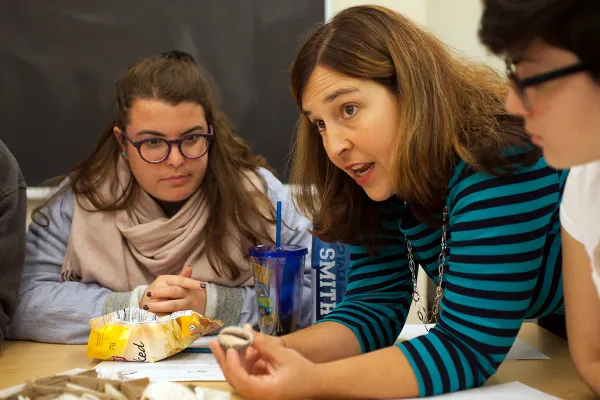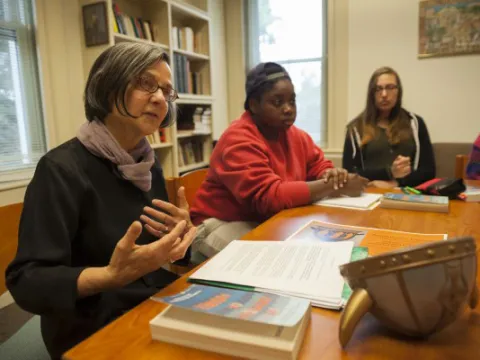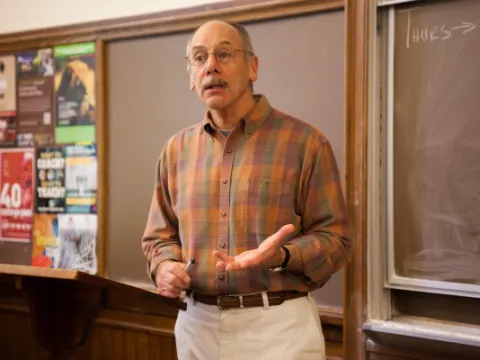Setting the Bar High: Sherrerd Prize Recipients Share Views on Standout Teaching
News of Note

Published October 13, 2015
Associate Professor of Geosciences Sara Pruss believes “there is no one right way to be an excellent teacher.”
Truly good teaching, Pruss says, is about embracing “who you are in the classroom” and showing compassion to students.
For Justina Gregory ’67, Sophia Smith Professor of Classical Language and Literatures, “attentiveness” is key to the ability to reach students’ hearts and minds.
Alan N. Rudnitsky, professor of education and child study, says multiple qualities are needed for good teaching—with curiosity, empathy, humor and humility topping the list.
The three faculty members are this year’s winners of the college’s Kathleen Compton Sherrerd ’54 and John F. Sherrerd Prize for Distinguished Teaching. The honor is given annually to Smith faculty members who have elevated teaching to the highest levels of art and science.
This year’s winners join a roster of outstanding faculty who have received Sherrerd Prizes since the awards were established in 2004. A ceremony for the 2015 recipients will be held Wednesday, Oct. 21, at 4:30 p.m. in the Campus Center Carroll Room. Current and former students of the honorees will introduce each award recipient. A reception, open to all, will follow on the second floor of the Campus Center.
The accomplishments of this year’s honorees are evident in their biographies—and in comments accompanying the award nominations submitted by Smith students and faculty.

Students say Sherrerd Teaching Prize recipient Justina Gregory makes the ancient world come alive in the classroom. Photo by Carolyn Brown ’16.
Gregory, who has been teaching at the college since 1975, is a renowned scholar of Greek tragedy and intellectual history. Students describe her as inspiring and respectful of their ideas—someone who “has made the ancient world come alive” in the classroom.
Pruss, a member of the Smith faculty since 2007, excels at getting her students to “think like scientists,” colleagues say. Her research covers invertebrate paleontology, marine science and the history of life on earth. As faculty director of the college’s Achieving Excellence in Mathematics, Engineering and Science (AEMES) mentors, Pruss has helped students from diverse backgrounds thrive in STEM studies.
Rudnitsky, now in his 39th year of teaching at Smith, is viewed as a champion of big ideas and “deep learning” in the classroom. Through his research—including a National Science Foundation-funded study on digital learning—and his own innovative classroom techniques, Rudnitsky has inspired students and faculty members alike to think differently about teaching and learning.
To shed more light on their accomplishments, we asked the three honorees a series of questions about the challenges and rewards of teaching. Their answers help illustrate what sets them apart as educators.

Sherrerd Teaching Prize recipient Prof. Alan Rudinitsky is in his 39th year of teaching at Smith. Photo by Carolyn Brown ’16.
One question they all answered the same: What’s the best thing about teaching at Smith?
“In a word, the students,” Rudnitsky said, echoing comments made by his fellow Sherrerd Prize recipients.
Here’s what else they had to say:
What inspired you to become an educator?
Justina Gregory: “I became an educator incrementally, rather than through inspiration. I majored in classics at Smith and was a promising enough student that my professors encouraged me to continue on for a Ph.D. Despite the rigors of graduate school, I continued to love my field of study and to enjoy thinking and writing about Greek tragedy in particular. In my fourth year of graduate school, I began working as a teaching assistant and discovered how rewarding teaching could be.”
Sara Pruss: “I had a few fantastic teachers in my early years, as well as during my time at college. They believed in me and made me feel like I could accomplish anything. Once I discovered what I loved—and realized that I could have a job inspiring people to do what they love and push them in new directions—it was a very easy decision.”
Alan Rudnitsky: “As an undergraduate at Drexel University in Philadelphia in the late 1960s, I was majoring in science. It was a tumultuous time in the world and I began working in a startup community-controlled school that was one of the initiatives funded by the War on Poverty. I loved it! It was clear I wanted to teach and be around kids. I went on to get a master’s degree and to teach in an elementary school in Vermont. I then entered a doctoral program at Cornell at a time when the cognitive revolution was beginning. That set my course ever since: Trying to understand how understanding develops.”
What’s the biggest challenge you’ve faced as a teacher?
Gregory: “Professing the humanities in a culture that seems to undervalue those disciplines. My colleagues and I are convinced that the habits of inquiry we model and the intellectual and ethical values embedded in the texts we present will sustain our students for the rest of their lives. But it can be difficult to remain affirmative and optimistic in the face of societal indifference to what the humanities have to offer.”
Pruss: “It took me a while to realize the enormous variety that exists in the way students process information and learn. No two students are the same, so you constantly have to adjust how you offer material and evaluate results. That’s also one of the most rewarding aspects of teaching.”
Rudnitsky: “The students I teach now at Smith have been and are very successful students. The assessment-centered educational system they’ve been schooled in has often focused on grades over learning. So part of being successful has meant being strategic. But to learn with understanding, you have to be willing to take risks. As we explore how people learn and what best practices in teaching look like, I encourage students to take risks. Trying to get people to do that is challenging.”
What’s a lesson you’ve learned from your students?
Gregory: “Being a teacher is like being a parent: you come to recognize your limitations. Generations of students have taught me that they will eventually move beyond what I have to give them, make their own mistakes and find their own solutions. They’ve taught me that this process is not only inevitable, but good.”
Pruss: “My Smith students have taught me to set the bar high. In my first semester at Smith, the students intervened and asked me to ‘help them a little less’ during the lab because they felt I wasn’t giving them enough space to figure things out on their own. They really embrace challenges and constantly surprise me with their maturity and abilities. So now I set the bar pretty high—in the classroom and in my research lab.”
Rudnitsky: “I’m learning from my students all the time, in part because the topic we are exploring is teaching and learning. This is what we’re studying, but it’s also what we’re doing. They are a constant source of new perspectives and new ideas for me. While we now know a lot about what good education looks like, the diversity of experiences and backgrounds that students bring always deepens my understanding and my appreciation for the process of teaching and learning.”
How has digital technology changed your teaching?
Gregory: “While technology has facilitated access to certain materials that I use in teaching, it hasn’t changed the three-way interchange among text, instructor and students that is fundamental to my pedagogy.”
Pruss: “Digital technology and the instant availability of information means that time in the classroom does not necessarily need to involve rehashing things the students can access and read on their own. It changes the way I use classroom time and has made my work more inquiry-based.”
Rudnitsky: “Where I see technology being important is as a way to sustain good discourse. I teach students that learning has an important social component and social interaction is at the heart of good discourse. Some people think big classes are like going to a movie. You might sit with your friends and chat quietly. Then once the film starts, it doesn’t matter who else is in the theater. But in education, it does matter who else is in the room. I see promise in technology helping us sustain discourse beyond the classroom walls.”
If you had to pick one quality that is essential for good teaching, what would that be?
Gregory: “Attentiveness. Humanities instructors are trained to perform close reading of a text. But it’s equally important to read both the individual student and the class as a whole and be prepared to adjust the lesson plan accordingly.”
Pruss: “There are a couple of things. One is to embrace who you are in the classroom and not to worry about trying to be like anyone else. Some people are naturally more quiet, some tell jokes, others initiate conversations on difficult topics. There is no one right way to be an excellent teacher. That being said, I think every teacher should have some compassion. There are so many things happening with all of our students every semester, and having compassion for whatever it is they might be going through makes a big difference.”
Rudnitsky: “I can’t pick just one. Curiosity, empathy, humor. I see those as key. And by humor I don’t mean just telling jokes, but being able to laugh at yourself. Humility is also important, knowing how hard good teaching is and how up and down it is. I am aware of how much all of my colleagues at Smith are doing to foster learning.”
Associate Professor of Geosciences Sara Pruss is one of three faculty members chosen for this year's Sherrerd Teaching Prize. The others are Justina Gregory, Sophia Smith Professor of Classical Languages and Literatures, and Alan Rudnitsky, professor of e